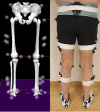Don't Peak Too Early: Evidence for an ACL Injury Prevention Mechanism of the 11+ Program
- PMID: 35949375
- PMCID: PMC9340830
- DOI: 10.26603/001c.36524
Don't Peak Too Early: Evidence for an ACL Injury Prevention Mechanism of the 11+ Program
Abstract
Background: The 11+ program prevents anterior cruciate ligament (ACL) injuries in athletes through unknown mechanisms.
Purpose: The aim of the current study was to evaluate the effects of The 11+ intervention program, performed by female soccer players during a single season, on the frequency of Early Peaks during athletic tasks.
Methods: Three teams (69 players) of collegiate female soccer athletes (Divisions I and II) were recruited. Two teams (49 players) volunteered to perform The 11+ three times per week for one season (~22 weeks plus three weeks pre-season), and one team (20 players) served as controls. The athletes performed three repetitions of a cutting maneuver, side shuffle direction change, and forwards to backwards running direction change before and after the competitive season and were recorded using marker-based 3D motion capture. Knee valgus moment time series were calculated for each repetition with inverse kinematics and classified as either "Very Early Peak", "Early Peak" or "other" using cluster analysis. The classification was based timing of the peak relative to the timing of ACL injuries. The effect of the intervention on the frequency of Very Early Peaks and Early Peaks was evaluated with a mixed Poisson regression controlling for the movement task and pre-season frequency.
Results: The 11+ intervention reduced the frequency of Early Peak knee valgus moment in one intervention team (coefficient = -1.16, p = 0.004), but not the other (coefficient = -0.01, p = 0.977). No effect was observed on the frequency of Very Early Peak knee valgus moment.
Conclusions: Reduced frequency of knee valgus moment Early Peak during athletic tasks may explain the mechanism by which The 11+ program decreases risk of ACL injury. Prospective studies with a much larger sample size are required to establish a link between Early Peak knee valgus moments and risk of ACL injury.
Level of evidence: 2b.
Keywords: Cluster analysis; biomechanics; injury prevention; knee; soccer.
Conflict of interest statement
The authors have no conflicts of interest.
Figures




Similar articles
-
Biomechanical Effects of an Injury Prevention Program in Preadolescent Female Soccer Athletes.Am J Sports Med. 2017 Feb;45(2):294-301. doi: 10.1177/0363546516669326. Epub 2016 Oct 29. Am J Sports Med. 2017. PMID: 27793803 Free PMC article.
-
Age Influences Biomechanical Changes After Participation in an Anterior Cruciate Ligament Injury Prevention Program.Am J Sports Med. 2018 Mar;46(3):598-606. doi: 10.1177/0363546517744313. Epub 2017 Dec 27. Am J Sports Med. 2018. PMID: 29281799
-
Does the FIFA 11+ Injury Prevention Program Reduce the Incidence of ACL Injury in Male Soccer Players?Clin Orthop Relat Res. 2017 Oct;475(10):2447-2455. doi: 10.1007/s11999-017-5342-5. Clin Orthop Relat Res. 2017. PMID: 28389864 Free PMC article. Clinical Trial.
-
Prevention of non-contact anterior cruciate ligament injuries in soccer players. Part 1: Mechanisms of injury and underlying risk factors.Knee Surg Sports Traumatol Arthrosc. 2009 Jul;17(7):705-29. doi: 10.1007/s00167-009-0813-1. Epub 2009 May 19. Knee Surg Sports Traumatol Arthrosc. 2009. PMID: 19452139 Review.
-
Prevention of non-contact anterior cruciate ligament injuries in soccer players. Part 2: a review of prevention programs aimed to modify risk factors and to reduce injury rates.Knee Surg Sports Traumatol Arthrosc. 2009 Aug;17(8):859-79. doi: 10.1007/s00167-009-0823-z. Epub 2009 Jun 9. Knee Surg Sports Traumatol Arthrosc. 2009. PMID: 19506834 Review.
Cited by
-
The early peak knee abduction moment waveform is a novel risk factor predicting anterior cruciate ligament injury in young athletes: A prospective study.Knee Surg Sports Traumatol Arthrosc. 2025 May;33(5):1677-1685. doi: 10.1002/ksa.12471. Epub 2024 Sep 12. Knee Surg Sports Traumatol Arthrosc. 2025. PMID: 39262328 Free PMC article.
References
-
- Athletic performance and career longevity following anterior cruciate ligament reconstruction in the National Basketball Association. Kester B S, Behery O A, Minhas S V, Hsu W K. 2017Knee Surg Sports Traumatol Arthrosc. 25(10):3031–3037. doi: 10.1007/s00167-016-4060-y. PMID: 26971105 ISBN: 0942-2056. - DOI - PubMed
-
- Increased incidence of osteoarthritis of knee joint after ACL reconstruction with bone–patellar tendon–bone autografts than hamstring autografts: a meta-analysis of 1,443 patients at a minimum of 5 years. Xie Xiaobo, Xiao Zhuo, Li Qi, Zhu Bo, Chen Jingxian, Chen Huamu, Yang Fangyuan, Chen Yuting, Lai Qianwei, Liu Xuzhou. 2015European Journal of Orthopaedic Surgery & Traumatology. 25(1):149–159. doi: 10.1007/s00590-014-1459-3. publisher: Springer Paris ISBN: 1633-8065. - DOI - PubMed
-
- A meta-analysis of meta-analyses of anterior cruciate ligament injury reduction training programs. Webster K E, Hewett T E. 2018J Orthop Res. doi: 10.1002/jor.24043. https://onlinelibrary.wiley.com/doi/abs/10.1002/jor.24043 PMID: 29737024 ISBN: 0736-0266. - DOI - DOI - PubMed
-
- Exercise-based knee and anterior cruciate ligament injury prevention. Arundale Amelia J.H., Bizzini Mario, Giordano Airelle, Hewett Timothy E., Logerstedt David S., Mandelbaum Bert, Scalzitti David A., Silvers-Granelli Holly, Snyder-Mackler Lynn, Johnson Brenda. 2018Journal of Orthopaedic and Sports Physical Therapy. 48(9):A1–A25. doi: 10.2519/jospt.2018.0303. PMID: 30170521. - DOI - PubMed
Grants and funding
LinkOut - more resources
Full Text Sources
Research Materials
